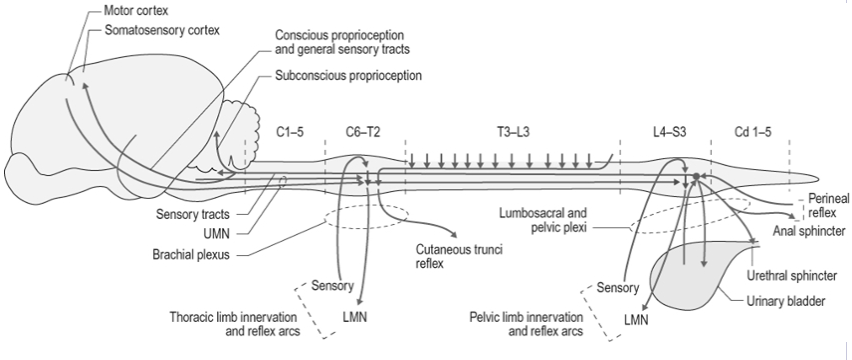Tags: Bandscheibenvorfall, IVDD,

| Location of lesion | Loss of sensory input | Presence of UMN signs | Presence of LMN signs to limbs Loss of other reflexes | Loss of urinary and faecal continence |
| Cervical C1–5 | TL, trunk, PL, tail | TL and PL both affected | No LMN signs in TL and PL. Cutaneous trunci and perineal reflexes intact | UMN bladdera Faecal incontinencec |
| Cervical intumescence C6–T2 | TL, trunk, PL, tail | PL only | TL, loss of cutaneous trunci reflex if lesion in C8–T2. Perineal reflex intact | UMN bladder Faecal incontinencec |
| Thoracolumbar T3–L3 | Trunk (caudal to lesion), PL, tail | PL only (TL normal) | No LMN signs in TL or PL Cutaneous trunci reflex lost caudal to lesion, perineal reflex intact | UMN bladder Faecal incontinence |
| Cranial lumbosacral L4–S1 | PL, tail | No UMN signs to limbs | LMN signs in PL Cutaneous trunci reflex intact, perineal reflex intact | UMN bladder Faecal incontinence |
| Caudal lumbosacral S1–S3 | Tail, PL probably normald | No UMN signs to limbs | LMN signs to pelvic viscera. Loss of perineal reflex | LMN bladderb LMN anal sphincter (dilated anus), faecal incontinence |
| Caudal nerves Cd1–5 | Tail | No UMN signs | LMN signs to tail | Normal continence |
TL = thoracic limb, PL = pelvic limb
a = UMN bladder – turgid, full, difficult to express
b = LMN bladder – flaccid, distended, easy to express, dribbling urine
c = Animal will deposit faeces with good emptying of colon, but may not be aware that it is defaecating.
Note: Whether or not all signs are present depends on lesion severity.